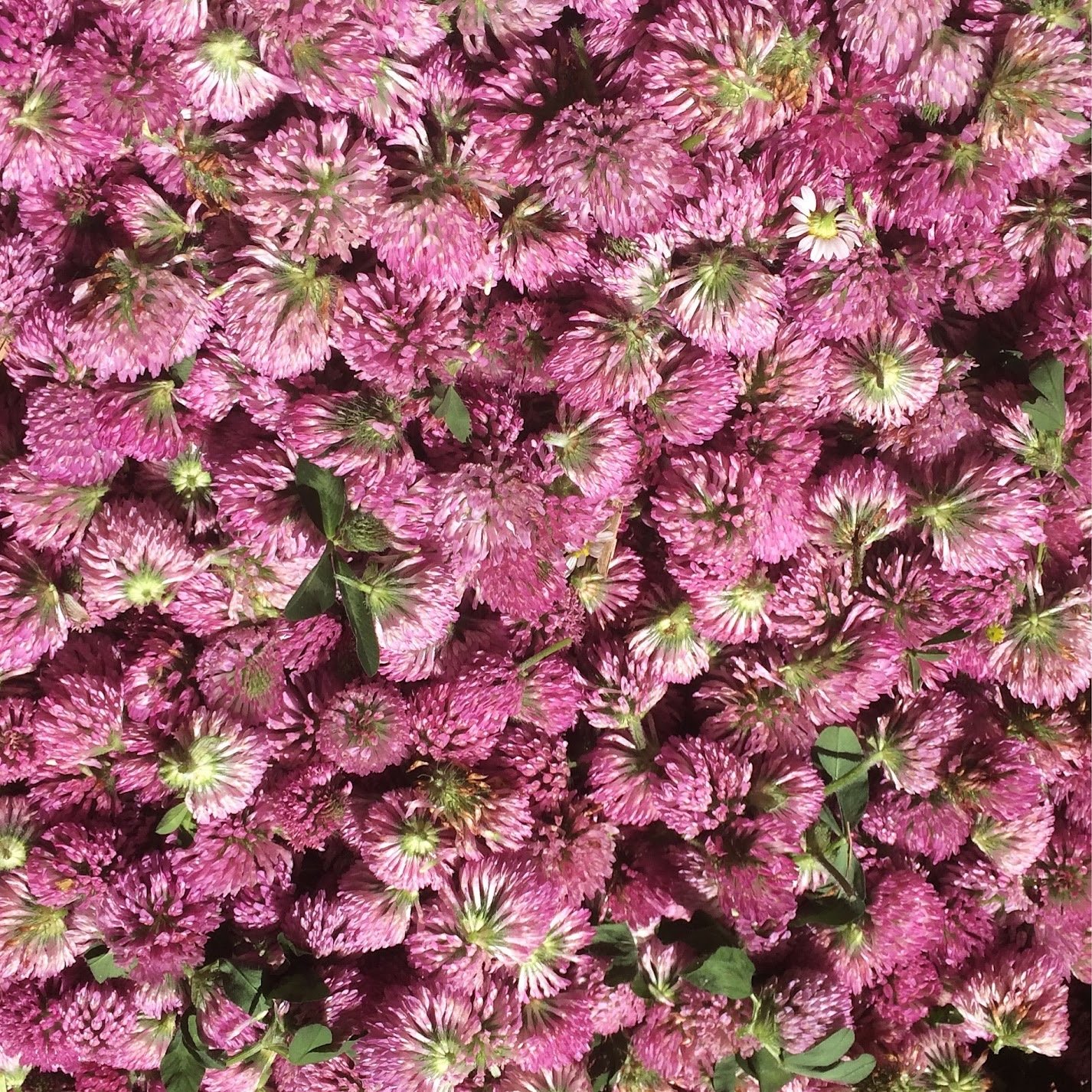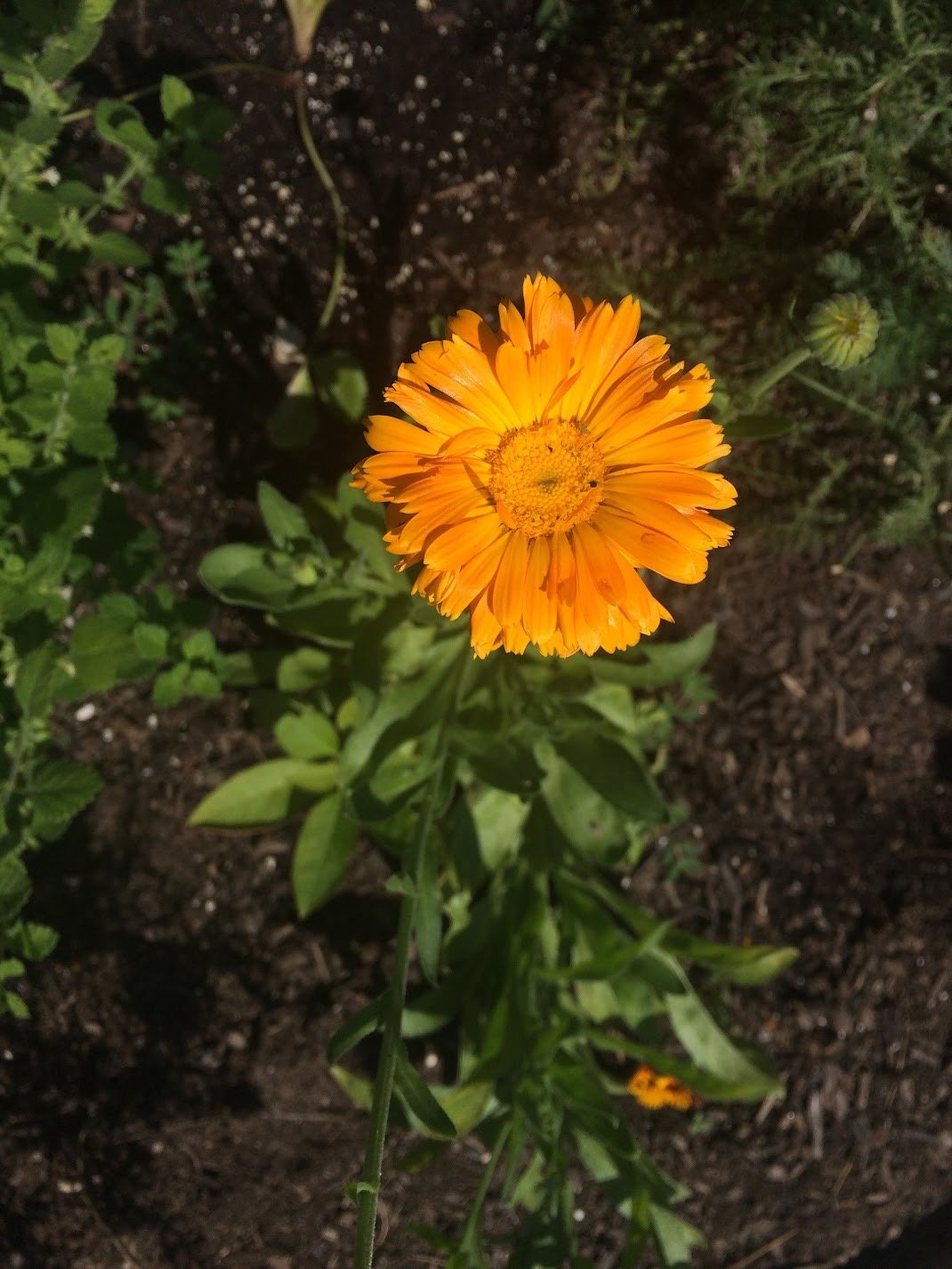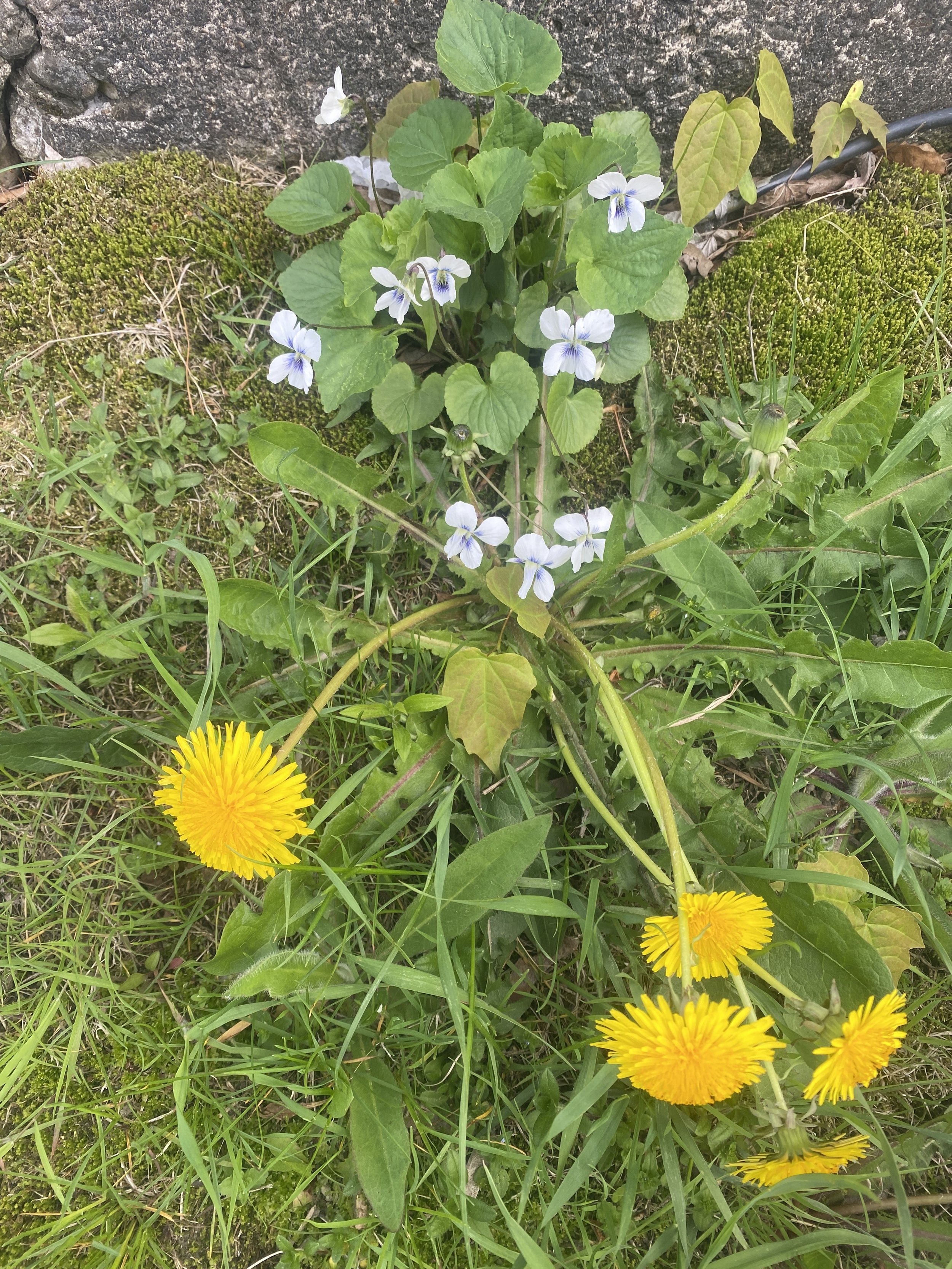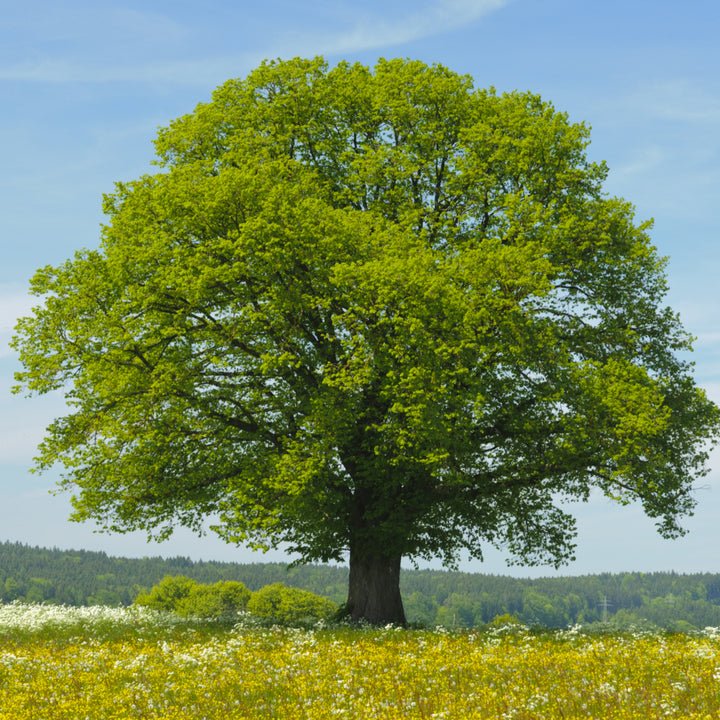Go with the flow…
Red Clover, a springtime lymphatic herb.
Lymphatic herbs to support shifts in the physical & energetic body.
Times are always changing. That’s life, isn’t it? There is a constant ebb and flow we must learn to adapt and adjust to. Many herbalists might go straight to, “adaptogens for times of change!” and this is true, adaptogens can be integral for supporting the adrenals during times of change. However, in my personal experience, lymphatic herbs provide a unique and invaluable type of support during these shifts. Lymphatics quite literally help to remove waste from the body, and if you work with the plant spirit medicine, you can invite them to remove waste from your emotional body as well.
Lymphatics, as the name indicates, have an affinity for the lymphatic system, the waste system of the body. Eclectics considered them to be “blood purifiers" known to clear toxicity from the tissues. Most lymphatic herbs have energetics that remedy the “dry atrophy” tissue state and can be helpful when there is swelling, hard nodules and cysts, and fibrous tissue. Many of these traditional lymphatic herbs are nutrient dense, a little salty, providing replenishment and nourishment to our cells and blood. Some of these herbs, like red clover, cleavers, or violet, are sweet tasting. Sweet indicates salt, which provides moisture necessary to remedy the dry atrophy state. Salt stimulates the kidneys, acting as a diuretic and helping flush fluids through the body. Then we have other lymphatics, like calendula, which is slightly bitter in taste and stimulates the liver/gallbladder to encourage gentle movement, which the lymph requires to release waste.
We can see how lymphatic herbs support the physical body - helping to break down hard tissue, move waste, and stimulate detox through the kidneys and liver. Now we can see how the energetics can be applied as “spirit medicine” to our emotional body.
For many of us, change can be hard. We may resist and feel ourselves become stuck. When we create a roadblock in the energetic body, just as in the physical body, “junk” can start to accumulate. This is where I like to apply energetic properties to the emotional body. They can invite softness to what might be feeling hard. With their sweet flavor, they can invite a little sweetness to a situation that might feel otherwise challenging. The salt element can open up channels physically and emotionally, allowing for movement, flow, and transformation. I am fond of the duo violet and red clover as an infusion - violet with its demulcent, cooling, gentle energy (and its affinity for the heart), and red clover for its sweet, nourishing, purifying properties. The plant spirits together remind me to “soften and flow” through difficult times. And, as someone with a predisposition for hormonal acne (especially during more stressful occasions), this pair helps me purge what may be stuck so that it doesn’t come out as a hard cyst on my face.
Another energetic/spiritual component to consider when working with plants, in general, but also specifically for moving us through times of change, is the flowering tops. The vibrational frequency of flowers has a direct impact on our energy field, whether working with the flower as a tea, an essence, or simply cutting it and bringing it into the home. My favorite lymphatic herbs all happen to flower - red clover, violet, and calendula (and technically cleavers, though the flowers are quite dainty). To me, the flowering tops contain a special magic in their medicine that exists in ethereal realms. I am fond of observing them bob against the gentle breeze, nodding their heads as if to say “yes, yes it is time to shift, you have permission, we will gently move you through this.” For example, calendula, with its brilliant bright orange blossoms, has been used traditionally to ward off evil spirits - it has been hung in garlands over doorways, added to sachets for protection, or blended in with a violet/red clover tea infusion.
The best way to work with lymphatics is through a water infusion. We are working with the waters of the body after all, and want to feel the plant spirit washing through us (plus many of these plants stimulate the kidneys and flush through the urinary system). And of course, water holds the frequency of the plants, as well as drawing out minerals. Creating a tea ritual for yourself can add an extra element of spirit healing to working with the plants. There is nothing quite as magical as taking a pause in your day to brew yourself a cup of tea, wait for it to steep, draw a card, journal, or take a few minutes to drop into meditation with the plant and invite its guidance. Of course, you can always brew your infusion overnight, strain, and sip throughout the day.
Tea recipe to invite flow during times of change:
2 Parts Violet Leaf & Flower
2 Parts Red Clover Flowering tops and leaf
1 Part Cleavers
½ Part Calendula blossoms
Blend the herbs dry or fresh and steep in hot water for at least 15 minutes. You can also leave these steeping in a covered mason jar overnight for a potent morning tea.
Spring Herbs for Liver and Lymph Support
March has arrived, signaling the earth’s awakening from its winter slumber. The birds are singing, the light is changing, and we are starting to see the first glimpses of spring ephemerals. As beings of the earth, we feel this shift in our bodies. We consider how we too may gently begin waking up and take notice of what needs tending to. In the inherent wisdom of nature, the first plants that come back to life happen to be the very allies to support our bodies as we move into the next season.
According to Traditional Chinese Medicine, each season is associated with a different organ system. Spring is the season of the liver. Liver tonic herbs are a great way to support our bodies after a season of rest and indulging in comfort foods. In spring, some of the first herbs to pop up are the best allies to support our livers/detox system: dandelion, burdock, violet, and nettles. These plants are deeply nourishing to the body and are safe for daily consumption. They support the liver, help to ensure proper detoxification, and provide essential vitamins and minerals.
Dandelion is perhaps the most prolific “wild weed” in our spring tonics collection. Universally recognized by its yellow-headed flowers and for its resilience - I’ve witnessed it pop up through cracks in the pavement and along the sidewalks in the city. All parts of the plant can be harvested for therapeutic use. The leaf has an affinity for the kidneys while the root favors the liver, and the flowering top can be used to support both organ systems. The entire plant is very bitter in taste, indicating its ability to stimulate the production of bile and digestive secretions in the liver/gallbladder, and has a diuretic effect. The French call it “pis-en-lit” which translates to “pee the bed.” Dandelion roots are harvested either in the spring as the energy is ascending upwards or the fall as it descends back into the earth. The leaves may be enjoyed as salad greens in early spring but will become more bitter in taste as they continue growing. My favorite way to consume dandelion root is as a tea, paired with burdock.
Burdock is another classic spring bitter, and actually one of the less “bitter” liver herbs. Due to its polysaccharide content, it is surprisingly sweet. Sweet taste indicates the plant has deeply nutritive, building, tonic properties. The polysaccharides contain inulin, a prebiotic fiber that helps establish proper gut microflora. This biennial plant sprouts up with broad slightly curly leaves and by the second year grows huge, and “flowers” with its famous burrs that stick like velcro (and in fact were the inspiration for velcro) to any passersby. The root is traditionally used in Japanese cooking and in tea infusions. Fresh burdock root has the magical ability to turn the water a beautiful teal color. Drunk daily, burdock assists in the liver’s detoxification process, helps balance blood sugar, and is known to support the skin - though traditionally it is the seeds that are used for skin health. Burdock root is traditionally harvested in the fall of its first year of growth. Be careful when harvesting this taproot not to cut off the root before you get to the bottom.
Heart-shaped violet leaves pop up, deep vibrant green and close to the ground, bejeweled with purple or white flowers. Violet is soft, sweet, and gentle in urging us to flow - it has an affinity for the lymphatic system. The lymph is the waste system of the body, and does not move on its own - it relies on us to help it carry its waste to the liver. We can do this through gentle movement, dry brushing, and lymphatic herbs. Violet is one of the most beautiful plant spirits to invite during times of hardship, physical or emotional. Violet is indicated for hard cysts or painful nodules, specifically in the breast. It makes a dreamy addition to any tea blend for keeping the waters of the lymph flowing (I love a cleavers, violet, dandelion trio). This plant is best prepared as a fresh tea or oil infusion. Collecting fresh violet leaves and flowers for a solar infused oil is one of my favorite springtime traditions. Once infused, the oil can be used for whole body lymph massage or on specific areas that need attention.
Stinging nettle is one of the very first plants to pop its sweet head up in the garden each spring. Most people know of its infamous sting. Some interpret this friendly little zap as a way nettle tries to wake us up, especially after a long, perhaps stagnant winter. One old folk tradition used bundled nettle in flagellation ceremonies for pain. The fibers of nettle have traditionally been used as a textile. Taken internally, nettle is perhaps the most deeply nourishing, mineral rich herb. An overnight infusion will draw out more minerals, leaving you with a rather savory tea to sip. Aside from the mineral content, nettle acts as a "natural anti-histamine." When taken daily, it is known to help support those with seasonal allergies. This plant is considered to be drying, which can help those pesky damp mucus membranes. For allergies, I find tincture or capsules is most effective. However, my favorite way to work with any plant is always as a tea. Look out for young nettle this spring. Young nettles do not contain as many of the little stinging trichomes, and after they have been blanched can be added to many culinary recipes, or brewed into a tea. Be sure to wear gloves when harvesting nettle!
Aside from brewing tea infusions and tinctures, here are some of my favorite ways to incorporate spring plants into my daily life:
Wild Greens Spring Salad
2 cups Spring mix or arugula
1 cup freshly harvested violet leaf and flower
1 cup freshly harvested chickweed
½ cup freshly harvested young dandelion leaves
Goat cheese crumbles to your liking
Salt & pepper
Drizzle of olive oil
Squirt of lemon
Add-in option, come June: Wild strawberries
Young Nettle Pesto
2 cups blanched young nettle leaves
⅓ cup walnuts
2 cloves garlic
3 tbs grated parmesan cheese
3 tbs olive oil
1 tsp salt
Juice of half a lemon
To blanch the nettles, use tongs to place fresh plant matter into boiling water for about 60 seconds. Remove from water, place on a clean dishtowel and squeeze out excess liquid.
Add ingredients to a food processor and blend until smooth
Violet Leaf Juice
4 cups freshly harvested violet leaves
2 cups water
Blend in vitamix and strain out plant matter.
Dandelion Head Fritters
1 cup freshly harvested dandelion heads
1 cup flour
1 cup milk
1 egg
Whisk flour, milk, and egg together in a bowl. Dip the dandelion heads in the mixture immediately after harvesting (the heads will close up if they aren’t used quickly). Fry in a pan with butter on medium heat until the batter turns golden brown. They are great on the spring green salad, or on their own dipped in your favorite sauce.
*A note on harvesting plants for consumption: make sure plants are grown away from areas that are sprayed with toxic chemicals or close to homes with lead paint where particles may still be absorbed into the soil where plants are growing
Other practices to support the liver as we move into spring include castor oil packs on the liver, finding healthy ways to express any anger (in TCM, the liver is the house of anger).
Linden
There is some extra magic in a flowering tree. A plant that contains both the grounding energy of a tree and the ethereal essence of a flower is truly a unique and powerful remedy. When linden blossoms in June, the heavenly fragrance remains suspended in the air, catches a ride on a breeze, and makes its way around the block. The aromatics are intoxicating on their own, and when leaves and flowers are harvested and brewed as a tea, linden offers a potent remedy to the heart and nervous system.
Linden - Tilia spp.
The linden tree can be recognized by its heart shaped leaves, indicating its affinity for the heart. Herbalists consider this the “doctrine of signatures,” or when looking at a plant tells you what organ system it remedies. Linden has traditionally been used as a cardio tonic, strengthening the heart and cardiovascular system with regular use. It is also a relaxant nervine, soothing those with anxiety that manifests in the heart/chest through palpitations and tightness. Energetically, linden is slightly cooling and moistening, making it a remedy for those with hot, dry tissue states - ranging from dry throats and hot fevers to burned out nervous systems.
Because of its aromatics and mucilage content, linden makes a delightful tea. Brewing a hot or cold extraction will work here, but the key is to let it infuse for at least 45 minutes to extract the mucilage. Water extracts the healing polysaccharides to create a soft, sweet floral tea. I enjoy a cup of linden tea when I feel frazzled, fried, and overwhelmed. Other specific indications for linden are grief, trauma, and shock.
There are many traditional uses for linden but my preferred use for this plant ally is through its “spirit medicine.” Linden is a supreme remedy for any heart that is hurting - to soothe the pain and tension held in the heartspace, allowing yourself to soften and drop into your body to connect with spirit. The primary way I like to connect with plant spirit medicine is through bath rituals. When we come to understand how water can change molecular structure and hold the vibrational frequency of plants, we open up a whole new world of ways to use water as a conduit for spirit medicine. In submerging yourself in an herbal path, we invite the wisdom and “medicine” of whatever plant ally we choose to work with.
For intense grieving and heartache, brew a strong infusion of linden tea, strain it, and add it into your bathwater (and maybe keep a little for yourself to drink). This is a ritual I learned from Robin Rose Bennett. The relief and comfort brought to the heart space when submerged in a bath of linden truly is an immense hug for the spirit. Draw yourself a magical linden bath with the intention of opening your heart to receiving whatever “medicine” linden has for you, light a candle, burn some blessing herbs, and maybe put on a Coyote Oldman playlist while you float into bliss.
Linden recipes:
Simple Linden Tea:
1 tsp of linden : 1 cup boiling water - cover and let steep for 45 minutes or overnight
Tea for Grief:
2 parts Linden
1 part Hawthorn
1 part Rose
Tea for Chest-centered Anxiety:
2 parts Linden
2 parts Lemon Balm
1 part Motherwort
½ part Lavender
Tea for Insomnia:
2 parts Linden
1 part Passionflower
1 part Chamomile
½ part Lavender
Tea for Fever:
2 parts elderflower
1 part linden
1 part yarrow












